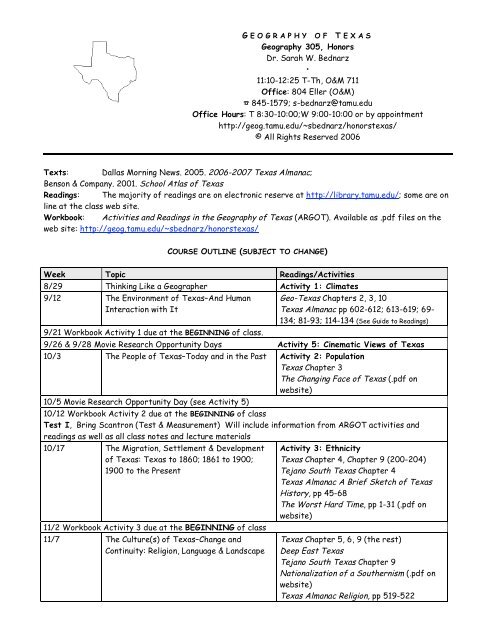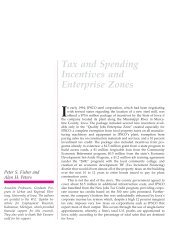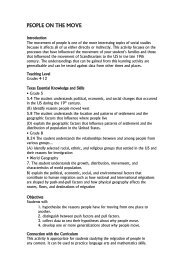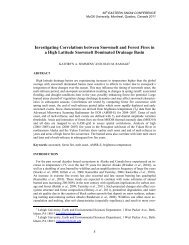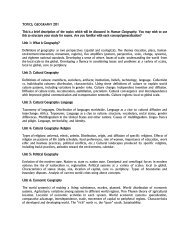Download PDF of Syllabus - Department of Geography - Texas A&M ...
Download PDF of Syllabus - Department of Geography - Texas A&M ...
Download PDF of Syllabus - Department of Geography - Texas A&M ...
You also want an ePaper? Increase the reach of your titles
YUMPU automatically turns print PDFs into web optimized ePapers that Google loves.
G E O G R A P H Y O F T E X A S<br />
<strong>Geography</strong> 305, Honors<br />
Dr. Sarah W. Bednarz<br />
•<br />
11:10-12:25 T-Th, O&M 711<br />
Office: 804 Eller (O&M)<br />
☎ 845-1579; s-bednarz@tamu.edu<br />
Office Hours: T 8:30-10:00;W 9:00-10:00 or by appointment<br />
http://geog.tamu.edu/~sbednarz/honorstexas/<br />
© All Rights Reserved 2006<br />
Texts: Dallas Morning News. 2005. 2006-2007 <strong>Texas</strong> Almanac;<br />
Benson & Company. 2001. School Atlas <strong>of</strong> <strong>Texas</strong><br />
Readings: The majority <strong>of</strong> readings are on electronic reserve at http://library.tamu.edu/; some are on<br />
line at the class web site.<br />
Workbook: Activities and Readings in the <strong>Geography</strong> <strong>of</strong> <strong>Texas</strong> (ARGOT). Available as .pdf files on the<br />
web site: http://geog.tamu.edu/~sbednarz/honorstexas/<br />
COURSE OUTLINE (SUBJECT TO CHANGE)<br />
Week Topic Readings/Activities<br />
8/29 Thinking Like a Geographer Activity 1: Climates<br />
9/12 The Environment <strong>of</strong> <strong>Texas</strong>–And Human<br />
Interaction with It<br />
9/21 Workbook Activity 1 due at the BEGINNING <strong>of</strong> class.<br />
Geo-<strong>Texas</strong> Chapters 2, 3, 10<br />
<strong>Texas</strong> Almanac pp 602-612; 613-619; 69-<br />
134; 81-93; 114-134 (See Guide to Readings)<br />
9/26 & 9/28 Movie Research Opportunity Days Activity 5: Cinematic Views <strong>of</strong> <strong>Texas</strong><br />
10/3 The People <strong>of</strong> <strong>Texas</strong>–Today and in the Past Activity 2: Population<br />
<strong>Texas</strong> Chapter 3<br />
The Changing Face <strong>of</strong> <strong>Texas</strong> (.pdf on<br />
website)<br />
10/5 Movie Research Opportunity Day (see Activity 5)<br />
10/12 Workbook Activity 2 due at the BEGINNING <strong>of</strong> class<br />
Test I, Bring Scantron (Test & Measurement) Will include information from ARGOT activities and<br />
readings as well as all class notes and lecture materials<br />
10/17 The Migration, Settlement & Development<br />
<strong>of</strong> <strong>Texas</strong>: <strong>Texas</strong> to 1860; 1861 to 1900;<br />
1900 to the Present<br />
11/2 Workbook Activity 3 due at the BEGINNING <strong>of</strong> class<br />
11/7 The Culture(s) <strong>of</strong> <strong>Texas</strong>–Change and<br />
Continuity: Religion, Language & Landscape<br />
Activity 3: Ethnicity<br />
<strong>Texas</strong> Chapter 4, Chapter 9 (200-204)<br />
Tejano South <strong>Texas</strong> Chapter 4<br />
<strong>Texas</strong> Almanac A Brief Sketch <strong>of</strong> <strong>Texas</strong><br />
History, pp 45-68<br />
The Worst Hard Time, pp 1-31 (.pdf on<br />
website)<br />
<strong>Texas</strong> Chapter 5, 6, 9 (the rest)<br />
Deep East <strong>Texas</strong><br />
Tejano South <strong>Texas</strong> Chapter 9<br />
Nationalization <strong>of</strong> a Southernism (.pdf on<br />
website)<br />
<strong>Texas</strong> Almanac Religion, pp 519-522
11/14 Politics in <strong>Texas</strong> <strong>Texas</strong> Chapter 7<br />
<strong>Texas</strong> Almanac Elections, pp 382-411<br />
11/21 The Economy(ies) <strong>of</strong> <strong>Texas</strong>–Earning a Living Activity 4: Visualizing <strong>Texas</strong> <strong>Geography</strong><br />
The Churn<br />
<strong>Texas</strong> Almanac Agriculture, pp 624-42,<br />
Business, pp 567-68; 574-5<br />
11/30 Workbook Activity 4 due. Movie Research Opportunity Day (see Activity 5)<br />
12/7 No class but Workbook Activity 5 due.<br />
Self Study Urban <strong>Texas</strong>–Cities and<br />
the Future<br />
Urban <strong>Texas</strong> Chapter 1<br />
On-line self-paced learning<br />
12/8 Test II, 3:00-5:00 p.m. Bring Scantron (Test & Measurement) and Bluebook. Will include<br />
information from ARGOT activities, readings and lecture materials since last test.<br />
Course Requirements<br />
1. Two examinations (40% <strong>of</strong> your grade).<br />
The exams will cover class lectures, readings on Electronic Reserve, and knowledge and skills gained from<br />
completing the ARGOT activities and readings. The tests are not cumulative except for questions from<br />
ARGOT.<br />
2. Activities and Readings in the <strong>Geography</strong> <strong>of</strong> <strong>Texas</strong> (ARGOT) activities (50% <strong>of</strong> your grade).<br />
How much do you know and can do with geography? These activities are designed to give you hands-on<br />
experience in discovering more about the topics discussed in class. Take time to do well on these activities.<br />
Quality is important. You may wish to work with a study group to ensure accuracy and completeness but be<br />
sure the work you submit is your OWN. Check university regulations regarding plagiarism at<br />
http://www.tamu.edu/aggiehonor. Each activity will count equally and be graded using a scoring rubric.<br />
The five projects you will complete are:<br />
Activity 1: Climate Graphs <strong>of</strong> <strong>Texas</strong><br />
Activity 2: Population Pyramids <strong>of</strong> <strong>Texas</strong><br />
Activity 3: Ethnicity in <strong>Texas</strong><br />
Activity 4: Visualizing <strong>Texas</strong> <strong>Geography</strong><br />
Activity 5: Cinematic Views <strong>of</strong> <strong>Texas</strong><br />
Descriptions <strong>of</strong> each activity and complete directions are available at<br />
http://geog.tamu.edu/~sbednarz/texashonors/argot.html<br />
3. Participation in the class seminar discussions (10% <strong>of</strong> your grade). This semester you will be<br />
expected to read one or two <strong>Texas</strong> newspapers on a daily basis and be prepared to discuss current trends<br />
and events in the context <strong>of</strong> the class topics and discussions. In addition, you should be prepared to ask and<br />
answer questions seminar style about the assigned readings.<br />
Final grades are awarded by examining the distribution <strong>of</strong> grades at the end <strong>of</strong> the semester.<br />
The usual grade distribution is approximately:<br />
12-15% A's<br />
30-35% B's & 30-35% C's<br />
12-15% D's and/or F's<br />
4. Attend class.<br />
It is imperative that you attend class on a daily basis in order to secure the knowledge necessary to<br />
succeed in this course. This is an inquiry class. The nature <strong>of</strong> your questions and participation are<br />
important and will influence your grade. For each absence, please submit a written explanation (excused
or unexcused) on your return to class. I will lower your grade if you have more than two unexcused<br />
absences. See the Student Handbook for definitions <strong>of</strong> excused absences.<br />
5. Keep up with the reading.<br />
The class discussions will be more meaningful and thus valuable if you keep up with the readings,<br />
contemporary events in <strong>Texas</strong>, and do ARGOT activities regularly. You may wish to discuss issues with<br />
members <strong>of</strong> your study group. Read the assigned articles carefully (unless other wise noted) and be<br />
prepared to share ideas gleaned from the articles. The Reader’s Guide will help you to identify important<br />
information from the <strong>Texas</strong> Almanac.<br />
Electronic Course Reserve Title <strong>Syllabus</strong> Title<br />
02: Physiographic Provinces <strong>of</strong> <strong>Texas</strong> Geo-<strong>Texas</strong> Chapter 2<br />
03: Population <strong>Geography</strong> <strong>Texas</strong> Chapter 3<br />
06 <strong>Texas</strong> Weather and Climate Geo-<strong>Texas</strong> Chapter 3<br />
09: <strong>Texas</strong> Environment Geo-<strong>Texas</strong> Chapter 10<br />
14 : Confluence <strong>of</strong> Cultures <strong>Texas</strong> Chapter 4<br />
16: Homeland Forged (Tejano South <strong>Texas</strong> Ch. 04) Tejano South <strong>Texas</strong> Ch. 04<br />
18: Linguistic <strong>Geography</strong> <strong>Texas</strong> Chapter 5<br />
19: <strong>Geography</strong> <strong>of</strong> Religion <strong>Texas</strong> Chapter 6<br />
25: Rural Settlement <strong>Geography</strong> <strong>Texas</strong> Chapter 9<br />
29: Political <strong>Geography</strong> <strong>Texas</strong> Chapter 7<br />
35: Rise <strong>of</strong> Urban <strong>Texas</strong> Urban <strong>Texas</strong> Chapter 1<br />
38:Tejano Cultural Province (Tejano South <strong>Texas</strong><br />
Chapter 09)<br />
Tejano South <strong>Texas</strong> Chapter 9<br />
Deep East <strong>Texas</strong> Deep East <strong>Texas</strong><br />
The Churn The Churn<br />
<strong>Texas</strong><br />
Almanac<br />
Readers Guide<br />
Pp 602-612 History <strong>of</strong> Oil Discoveries in <strong>Texas</strong>. Read the summary captions <strong>of</strong> the other tables in this<br />
section. Note the map on page 607.<br />
Pp 613-619 Non-Petroleum Minerals. Note what, where, and the economic importance <strong>of</strong> each resource.<br />
Pp 69-134 Environment. Read the description <strong>of</strong> the regions <strong>of</strong> <strong>Texas</strong>, pp 70-73, and compare it to<br />
the Geo<strong>Texas</strong> chapters. Skims the section on soils, pp 77-80, asking yourself: What is the<br />
impact on agriculture <strong>of</strong> the pattern <strong>of</strong> soils? What are the various uses <strong>of</strong> the different<br />
soil types? Review the materials on plant life on pp 94-97 and compare to the class<br />
discussion.<br />
Pp 81-93 Water Resources. Pay special attention to the information on rivers, noting the location <strong>of</strong><br />
each river (source, mouth, and drainage basin), past uses versus present uses, the impact<br />
<strong>of</strong> each river on the environment in different regions <strong>of</strong> the state, and any special<br />
characteristics, e.g., early Anglo American settlement along the Brazos River; the Canadian<br />
River bridge difficulties<br />
Pp 114-134 Skim the description <strong>of</strong> weather in 2003-2004. Look at the data on destructive weather,<br />
tornadoes and drought, reading captions <strong>of</strong> tables and summarizing patterns and<br />
generalizations.<br />
Pp 519-522 Glean the general trends and update what you read in Chapter 6. Note the increasing<br />
diversity <strong>of</strong> religions in <strong>Texas</strong>.<br />
Pp 382-411 Pay attention to the spatial patterns in voter turn out by county (compare to ethnic<br />
patterns), changes in VAP. Compare to results in the November 2006 elections, especially<br />
in gerrymandered <strong>Texas</strong> congressional races.
Pp 624-42 Follow the trends in ag toward diversifying production and relate this to changes in the<br />
state’s population. Pay attention to what is grown, where, and why trends are changing.<br />
Pp 567-68;<br />
574-5<br />
Where is it expensive to live? Why? What is the state <strong>of</strong> the <strong>Texas</strong> economy?<br />
Exam and Quiz Policy<br />
If you are absent for an exam, a make-up will be <strong>of</strong>fered only if (1) you contact me either by phone or in<br />
person within 24 hours <strong>of</strong> the date, and (2) you provide me with a written doctor's note stating that you<br />
were incapacitated and unable to attend the exam. I will not contact the Health Center, nor is it a<br />
sufficient excuse for you to have been at the Health Center and thus to have missed the exam. Check<br />
University regulations regarding excused absences. If in doubt, call.<br />
Scholastic Dishonesty<br />
Be sure all work is original or carefully cited. Please see the University Regulations regarding scholastic<br />
integrity at http://www.tamu.edu/aggiehonor. I encourage you to work with a study group to complete<br />
activities and to learn the material. You will peer-review your classmates’ work. Note, however, that<br />
providing answers for any assigned work or copying someone else's work, either with or without their<br />
permission, is considered unethical and a violation <strong>of</strong> the University Code <strong>of</strong> Honor. It will cause you to lose<br />
all activity credit for the semester. Work cooperatively in your group and contribute; do not copy blindly.<br />
As commonly defined, plagiarism consists <strong>of</strong> passing <strong>of</strong>f as one’s own the ideas, words, writings, etc., which<br />
belong to another. In accordance with this definition, you are committing plagiarism if you copy the work<br />
<strong>of</strong> another person and turn it in as your own, even is you should have the permission <strong>of</strong> that person.<br />
Plagiarism is one <strong>of</strong> the worst academic sins, for the plagiarist destroys the trust among colleagues without<br />
which research cannot be safely communicated. If you have any questions regarding plagiarism, please<br />
consult the latest issue <strong>of</strong> the <strong>Texas</strong> A&M University Student Rules, http://student-rules.tamu.edu, under<br />
the section “Scholastic Dishonesty.”<br />
© The handouts used in this course are copyrighted. By "handouts," I mean all materials generated for this<br />
class. These include, but are not limited to, the syllabus, exams, workbook activities, etc. Because these<br />
materials are copyrighted, you do not have the right to copy them except for personal use unless I<br />
expressly grant permission.<br />
Equal Opportunities<br />
The Americans with Disabilities Act (ADA) is a federal anti-discrimination statute that provides<br />
comprehensive civil rights protection for persons with disabilities. Among other things, this legislation<br />
requires that all students with disabilities be guaranteed a learning environment that provides for<br />
reasonable accommodation <strong>of</strong> their disabilities. If you believe you have a disability requiring an<br />
accommodation, please contact the <strong>Department</strong> <strong>of</strong> Student Life, Services for Students with Disabilities in<br />
Room B118 <strong>of</strong> Cain Hall, or call 845-1637.<br />
Web Resources<br />
I encourage students to use technology to communicate with me and to learn more about this class and the<br />
geography <strong>of</strong> <strong>Texas</strong>. Please communicate with me via e-mail. I generally check my mail several times a day<br />
and will reply promptly to your inquiries. The web page for the honors GEOG 305 is:<br />
http://geog.tamu.edu/~sbednarz/texashonors.<br />
I will send important messages to the class via neo.tamu.edu.<br />
Classroom Behavior<br />
Please turn your cell phone <strong>of</strong>f when you enter the classroom. Please exhibit respect for your classmates<br />
and me through proper and appropriate classroom behavior.


